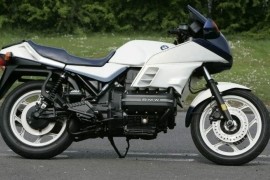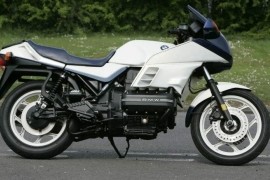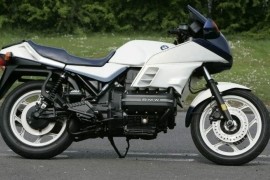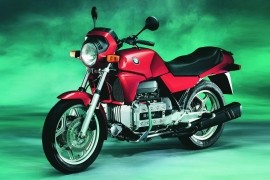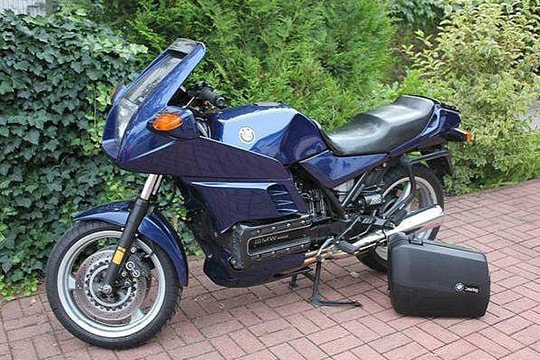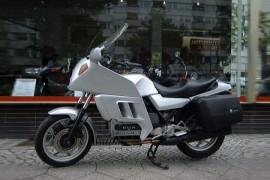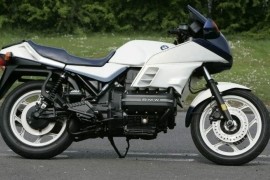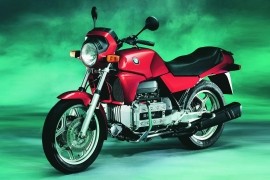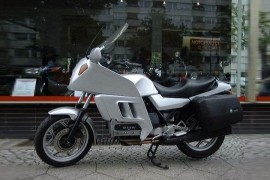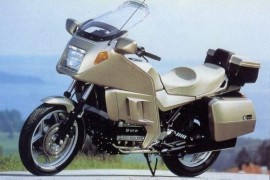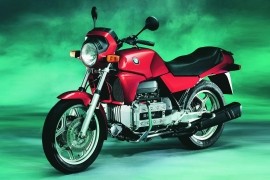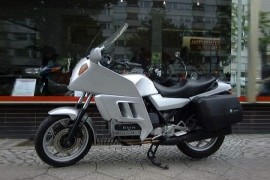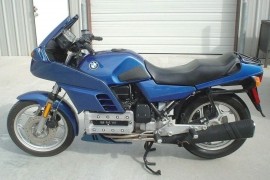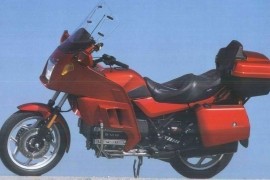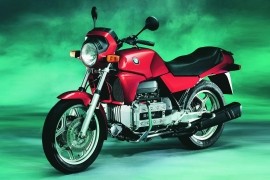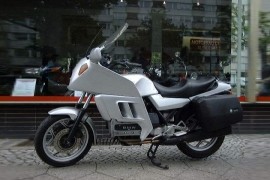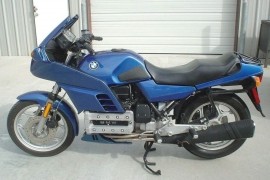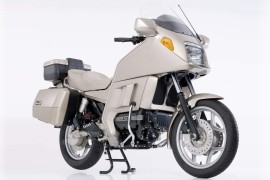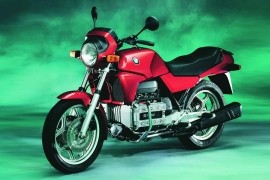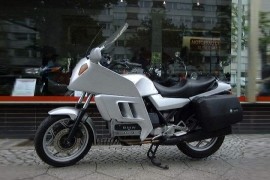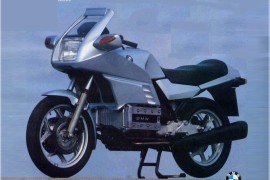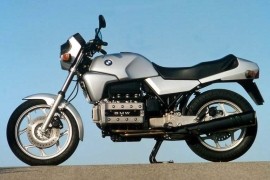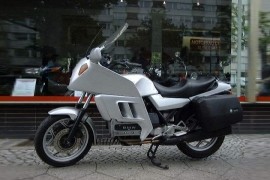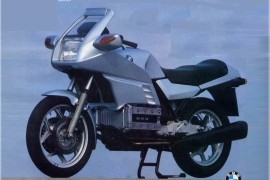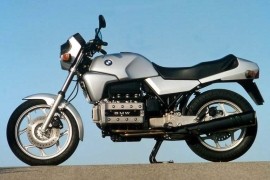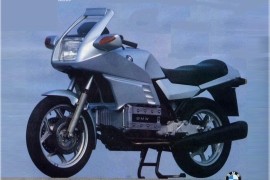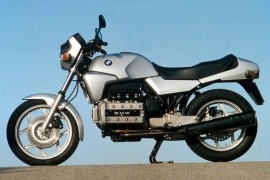BMW K 100 Models/Series Timeline, Specifications & Photos
First production year: 1982
The BMW K100 was a family of motorcycles manufactured by BMW from 1982 until 1992. The bike was also called the "Flying Brick" and was powered by a 987cc four-stroke in-line four-cylinder engine. In addition, from 1982 to 1992, the maker produced over 34,800 units.
The standard K100 model was made in several versions, such as the K100 RS with a fixed sports fairing and a lower handlebar, the K100 C with a small cockpit fairing mounted on the handlebar, the K100 RT with a full touring fairing, the K100 LT with a taller windscreen and luxury touring equipment, and K100 TIC designed for Police, Ambulance, Fire, and Military departments.
In 1991, the German motorcycle maker brought the BMW K100 RS into the market, a sports touring machine built for over nine years. Until 1988, the bike remained unchanged, while the 1989 model received a significant revision.
Some modifications brought to the 1989 model included a revised engine with more valves per cylinder, a new dual seat, a new handlebar, new footpeg brackets, lightened pistons, a new Bosch Motronic, new spacers between the fairing and mirrors, a new shifter chassis, a new latch design for the optional saddlebags, and more.
In the power department, the 1991 BMW K100 RS had installed a 987cc four-stroke liquid-cooled four-cylinder engine underneath its fuel tank, delivering 95 hp with a peak force at 7,500 rpm and 85 Nm (63 lb-ft) torque at 6,000 rpm.
In 1990, The German motorcycle manufacturer released the BMW K100 RS, a sports touring machine, in its eighth consecutive production year. Compared to the base K100 model, the RS version featured a fixed sports fairing and a lower handlebar.
The 1990 model came with the same package as the 1989 motorcycle, delivering the same visual, technical, and performance specifications without any significant modifications whatsoever.
The latest updates and improvements were made on the 1989 model, which included a revised engine with more valves per cylinder, a new dual seat, a new handlebar, new footpeg brackets, lightened pistons, a new Bosch Motronic, new spacers between the fairing and mirrors, a new shifter chassis, a new latch design for the optional saddlebags, and more.
In the aesthetic department, the 1990 model had standard fittings, like eight-spoke aluminum alloy wheels, a four-into-one exhaust system with a silencer mounted on the left-hand side, an engine cover, a one-piece dual seat, a windscreen, and a half fairing with a single headlight unit.
In terms of power, the 1990 BMW K100 RS took its muscles from a 987cc four-stroke liquid-cooled four-cylinder engine mounted at its core, boasting 95 hp with a peak force at 7,500 rpm and 85 Nm (63 lb-ft) torque at 6,000 rpm.
As for the braking power, the motorcycle's wheels were fitted with two 285 mm brake discs and a dual-piston caliper on the front and a 285 mm brake disc with a single-piston caliper on the rear.
The BMW K100 RS was a sports-touring motorcycle derived from the standard K100 model. The RS debuted in 1983 and addressed riders searching for a dependable, stable machine with enhanced performance.
In 1989, the German bike maker released the BMW K100 RS, a motorcycle in its seventh consecutive production year that brought several modifications that improved its overall capabilities.
Some improvements included a revised engine with more valves per cylinder, a new dual seat, a new handlebar, new footpeg brackets, lightened pistons, a new Bosch Motronic, new spacers between the fairing and mirrors, a new shifter chassis, a new latch design for the optional saddlebags, and more.
Visually, the bike had standard features, such as a half fairing with a single headlight unit, a windscreen, a one-piece dual seat, an engine cover, a four-into-one exhaust system with a silencer mounted on the left-hand side, and eight-spoke aluminum alloy wheels.
In the performance department, the 1989 BMW K100 RS had installed a 987cc four-stroke liquid-cooled four-cylinder engine that delivered more power and torque than its predecessor. 95 hp at 7,500 rpm and 85 Nm (63 lb-ft) torque at 6,000 rpm were sent to the rear wheel through a five-speed transmission and a shaft drive.
The braking system was retained from the previous model, comprising two 285 mm brake discs and a dual-piston caliper on the front and a 285 mm brake disc with a single-piston caliper on the rear.
The BMW K 100 was a family of 987cc four-cylinder motorcycles produced by BMW from 1982 to 1992. They were part of the standard or sport-touring class and were manufactured at BMW's plant in Spandau, Germany.
The K 100 model was available in different forms and designations, such as the base K 100 without a fairing, the K 100 C with a cockpit fairing mounted on the handlebar, the K 100 RS with a sports fixed fairing, the K 100 RT with a full touring fairing, the K 100 LT with a taller windscreen and more luxurious standard equipment, and the K 100 TIC made for Authorities.
In the aesthetic department, the bike had standard fittings, such as a round headlight integrated into a small cowl, a one-piece dual seat, a four-into-one exhaust system with a muffler mounted on the left-hand side, and aluminum wheels.
The bike was made around a steel frame with a telescopic fork on the front and a Monolever system on the rear that acted as suspension.
The braking power was achieved by two 285 mm brake rotors with two-piston calipers acting on the front wheel and a 285 mm brake disc with a single-piston caliper operating on the rear wheel.
As for power, the 1989 BMW K 100 had installed a 987cc four-stroke liquid-cooled four-cylinder engine underneath its fuel tank, boasting 90 hp at 8,000 rpm and 84 Nm (62 lb-ft) torque at 8,250 rpm.
In 1988, the German motorcycle manufacturer released the BMW K100 RS ABS, a sports touring motorcycle, in its fifth consecutive production year. The engineers from the House of Munich took the standard K100 RS and fitted it with an Anti-Lock Braking system.
The new Anti-Lock Braking System (ABS) improved the safety levels of the machine and offered greater confidence to the riders. Apart from the ABS, the bike retained all the features and specifications of the base model.
Aesthetically, the motorcycle was characterized by standard features, such as a half fairing with an integrated square headlight, a medium-sized windscreen, a one-piece dual seat with passenger handles, a luggage rack, a four-into-one exhaust system with a silencer mounted on the left-hand side, and eight-spoke aluminum alloy wheels.
The bike was built around a steel frame that housed the suspension system, which comprised a telescopic fork on the front with 185 mm of travel and a monolever swingarm with 110 mm of travel.
Braking-wise, the motorcycle's wheels packed two 285 mm brake discs and two-piston calipers on the front and a 285 mm brake disc with a single-piston caliper on the rear, delivering excellent stopping power enhanced by the ABS.
As for power, the 1988 BMW K100 RS ABS had installed a 987cc four-stroke liquid-cooled four-cylinder engine underneath its fuel tank, boasting 90 hp at 8,000 rpm and 84 Nm (62 lb-ft) torque at 8,250 rpm.
In 1988, the German motorcycle maker released the BMW K100 RT, a touring-oriented version of the base K100 mode that came dressed in a full fairing along with several touring-oriented accessories that enhanced its long-distance capabilities.
The BMW K100 was a line of standard or sport-touring 987cc four-stroke motorcycles manufactured by BMW from 1983 to 1992. The bike was assembled in Spandau, Germany, and was called the "Flying Brick."
The 1988 model came with the same package as previous models, delivering the same technical, visual, and performance specifications without any significant changes whatsoever.
Aesthetically, the motorcycle had standard features, like a full fairing with a large rectangular headlight, a large windscreen for better wind and debris protection, a one-piece dual seat with passenger grab handles, side-mounted lockable panniers, a center stand, and eight-spoke alloy wheels.
As for the power figures, the 1988 BMW K100 RT had its heartbeat set by a 987cc four-stroke liquid-cooled four-cylinder mounted underneath its clothes, delivering an output power of 90 hp with maximum strength at 8,000 rpm and 84 Nm (62 lb-ft) torque at 8,250 rpm.
In the braking department, the motorcycle's wheels were assisted by two 285 mm brake discs tied to dual-piston calipers on the front and a 285 mm brake disc coupled to a single-piston caliper on the rear.
In 1988, the German motorcycle manufacturer released the BMW K100 RS, a sports touring motorcycle that debuted in 1983. Until 1988, the bike remained unchanged, delivering the same features and specifications as previous models.
In addition to the base and RS models, the maker released other versions, such as the K100 C with a small cockpit fairing mounted on the handlebar, the K100 RT with a full touring fairing, the K100 LT with a taller windscreen and luxury touring equipment, and K100 TIC designed for Police, Ambulance, Fire, and Military departments.
The 1988 model packed the same standard fittings as the previous model, like a half fairing with a rectangular headlight, a windscreen with a small wind deflector mounted on top, a one-piece dual seat, a single muffler mounted on the left-hand side, a center stand, and eight-spoke alloy wheels.
The 1988 BMW K100 RS had its heartbeat set by a 987cc four-stroke liquid-cooled four-cylinder engine mounted underneath its fuel tank, boasting 90 hp at 8,000 rpm and 84 Nm (62 lb-ft) torque at 8,250 rpm.
A five-speed cable-operated manual transmission sucked the power from the engine and sent it to the rear end via a final shaft drive, launching the motorcycle to a top speed of 220 kph (136 mph).
From top speed to a complete halt, the bike relied on two 285 mm brake discs and two-piston calipers mounted on the front wheel and a 285 mm brake disc with a single-piston caliper mounted on the rear wheel.
In 1988, the German motorcycle maker released the BMW K 100, a naked motorcycle created by German engineers for those riders who wanted a gritty yet agile bike capable of tackling city traffic and weekend hauls.
The BMW K 100 was a line of 987cc four-cylinder motorcycles produced by BMW from 1982 to 1992. They were part of the standard or sport-touring class and were manufactured at BMW's plant in Spandau, Germany.
The K 100 model was available in different forms and designations, such as the base K 100 without a fairing, the K 100 C with a cockpit fairing mounted on the handlebar, the K 100 RS with a sports fixed fairing, the K 100 RT with a full touring fairing, the K 100 LT with a taller windscreen and more luxurious standard equipment, and the K 100 TIC made for Authorities.
As for the power figures, the 1988 BMW K 100 had installed a 987cc four-stroke liquid-cooled four-cylinder engine underneath its fuel tank, delivering 90 hp at 8,000 rpm and 84 Nm (62 lb-ft) torque at 8,250 rpm.
It came equipped with standard features, such as a round headlight integrated into a small cowl, a one-piece dual seat, a four-into-one exhaust system with a muffler mounted on the left-hand side, and aluminum wheels.
The BMW K100 was a family of standard or sport-touring 987cc four-stroke motorcycles manufactured by BMW from 1983 to 1992. The bike was assembled in Spandau, Germany, and was called the "Flying Brick."
In 1987, the German motorcycle manufacturer released the BMW K100 RT, a more touring-oriented version of the base model. It was dressed in a full fairing with several touring accessories that enhanced its overall capabilities.
The bike's aesthetic department was characterized by standard fittings, like a full fairing with a large rectangular headlight, a large windscreen for better wind and debris protection, a one-piece dual seat with passenger grab handles, side-mounted lockable panniers, a center stand, and alloy wheels.
The 1987 model came in the same shape and form as the previous one without any significant modifications, wearing the exact technical, visual, and performance specifications.
Power-wise, the 1987 BMW K100 RT had its soul brought to life by a 987cc four-stroke liquid-cooled four-cylinder mounted underneath its fuel tank, boasting 90 hp with maximum strength at 8,000 rpm and 84 Nm (62 lb-ft) torque at 8,250 rpm.
The bike's engine was coupled to a five-speed transmission with a dry, cable-operated clutch that sent the power generated by the engine to the rear wheel via a final shaft drive, launching the motorcycle to 215 kph (134 mph).
As for the stopping power, the motorcycle relied on two 285 mm brake discs tied to dual-piston calipers on the front and a 285 mm brake disc coupled to a single-piston caliper on the rear.
In 1987, the German motorcycle maker released the BMW K 100 LT, a more luxurious touring version of the base K 100 model that came dressed in a full fairing with a large windscreen and additional touring equipment.
The K 100 LT was part of the K 100 family, a line of 987cc four-cylinder motorcycles manufactured by BMW from 1982 to 1992. They were part of the standard or sport-touring class and were assembled at BMW's plant in Spandau, Germany.
The K 100 was the base model for other versions with different designations and appearances, like the K 100 C with a cockpit fairing mounted on the handlebar, the K 100 RS with a sports fixed fairing, the K 100 RT with a full touring fairing, the K 100 LT with a taller windscreen and more luxurious standard equipment, and the K 100 TIC made for Authorities.
The 1987 K 100 LT came with the same package as the previous one, delivering the same technical, visual, and performance specifications without any significant changes whatsoever.
Visually, the bike came with standard fittings, such as a full fairing with a rectangular headlight, a large windscreen, a one-piece dual seat, side-mounted panniers, a top box, a center stand, and eight-spoke aluminum wheels.
As for power, the 1987 BMW K 100 LT had its soul brought to life by a 987cc four-stroke liquid-cooled four-cylinder engine that delivered an output power of 90 hp at 8,000 rpm and 85 Nm (63 lb-ft) torque at 6,000 rpm.
In 1987, the German motorcycle manufacturer released the BMW K 100, a liter-class naked machine that debuted in 1983 and continued production until 1992. It was in the fifth consecutive production year and had the same technical, visual, and performance specifications without any changes.
In the visual department, the motorcycle had standard fittings, such as a round headlight integrated into a small cowl, a one-piece dual seat, a four-into-one exhaust system with a muffler mounted on the left-hand side, and aluminum wheels.
Power-wise, the 1987 BMW K 100 had installed a 987cc four-stroke liquid-cooled four-cylinder engine underneath the fuel tank, delivering an output power of 90 hp at 8,000 rpm and 84 Nm (62 lb-ft) torque at 8,250 rpm.
The bike was available in several versions, like the K100 C with a small cockpit fairing mounted on the handlebar, the K100 RS with a lower fairing and a sports fixed fairing, the K100 RT with a full touring fairing, the K100 LT with a taller windscreen and luxury touring equipment, and K100 TIC developed for Police, Ambulance, Fire, and Military departments.
A telescopic fork and two 285 mm brake discs with dual-piston caliper handled the bike's front end, while the rear end was controlled by a Monolever system and a single 285 mm disc with a single-piston caliper.
In 1986, the German motorcycle manufacturer launched the BMW K100, a sports touring motorcycle derived from the standard K100 model. The bike was suitable for those riders who wanted to spend as much time as possible behind the bars, whether solo or two-up.
Compared to the base model, the RT version was fitted with a full fairing, hard, lockable side-mounted panniers, and a sizeable adjustable windscreen. For those riders who liked their vacation in the saddle, the bike was fitted with a radio system with speakers.
Visually, the motorcycle had standard fittings, such as a full touring fairing, a single headlight unit, a tall windscreen, a one-piece dual seat, side-mounted lockable panniers, a four-into-one exhaust system with a silencer mounted on the left-hand side, a center stand, and eight-spoke alloy wheels.
The motorcycle was built around a steel frame with a hydraulic telescopic fork handling the front suspension and a monolever system with a single-sided swingarm controlling the rear-end suspension.
In the performance department, the 1986 BMW K100 RT had installed a 987cc four-stroke liquid-cooled four-cylinder underneath its clothes, delivering an output power of 90 hp with maximum strength at 8,000 rpm and 84 Nm (62 lb-ft) torque at 8,250 rpm.
The power produced by the engine was transmitted to a five-speed transmission with a dry, cable-operated clutch and then to the rear wheel via a final shaft drive, launching the motorcycle to 215 kph (134 mph).
The BMW K100 was a family of standard or sports touring motorcycles produced by BMW from 1982 until 1992. The bike was powered by an in-line four-cylinder engine and was known as the "Flying Brick."
The BMW K100 was marketed in several versions, like the K100 C with a small cockpit fairing mounted on the handlebar, the K100 RT with a full touring fairing, the K100 LT with a taller windscreen and luxury touring equipment, the K100 TIC designed for Police, Ambulance, Fire, and Military departments, and the K100 RS with sports fixed fairings and a lower handlebar.
In 1986, the German motorcycle maker released the BMW K100 RS, a sports touring motorcycle, in its fourth consecutive production year. The 1986 model packed the same technical, visual, and performance specifications as the previous model without any changes.
The visual department was characterized by standard fittings, like a half fairing with an integrated square headlight, a medium-sized windscreen, a one-piece dual seat with passenger handles, a luggage rack, a four-into-one exhaust system with a silencer mounted on the left-hand side, and eight-spoke aluminum alloy wheels.
As for the power figures, the 1986 BMW K100 RS had its soul brought to life by a 987cc four-stroke liquid-cooled four-cylinder engine assisted by a fuel injection system, delivering an output power of 90 hp at 8,000 rpm and 84 Nm (62 lb-ft) torque at 8,250 rpm.
The BMW K 100 was a family of 987cc four-cylinder motorcycles manufactured by BMW from 1982 to 1992. They were part of the standard or sport-touring class and were assembled at BMW's plant in Spandau, Germany.
The K 100 was the base model for other versions with different designations and appearances, like the K 100 C with a cockpit fairing mounted on the handlebar, the K 100 RS with a sports fixed fairing, the K 100 RT with a full touring fairing, the K 100 LT with a taller windscreen and more luxurious standard equipment, and the K 100 TIC made for Authorities.
In 1986, the German motorcycle manufacturer released the BMW K 100 LT, a more touring-oriented version of the base model with a tall windscreen and additional luxurious standard equipment.
The bike had standard features in the aesthetic department, such as a full fairing with a rectangular headlight, a large windscreen, a one-piece dual seat, side-mounted panniers, a top box, a center stand, and eight-spoke aluminum wheels.
The 1986 BMW K 100 LT had its heartbeat set by a 987cc four-stroke liquid-cooled four-cylinder engine that delivered an output power of 90 hp at 8,000 rpm and 85 Nm (63 lb-ft) torque at 6,000 rpm.
The bike's engine was married to a five-speed transmission that sent the power to the rear wheel via a final shaft drive, launching the motorcycle to a top speed of 213 kph (132 mph).
In 1983, BMW took a big step into modern times with the release of a four-cylinder in-line engine generation of motorcycles, as the BMW K 100 was unveiled in Paris. Working in the development department of BMW Motorrad, the engineer Josef Fritzenwenger had the idea of installing a four-cylinder in-line engine lying lengthways in a bridge frame with straight tubes.
The bike was available in several versions, like the basic K100 model without a fairing, the K100 C with a small cockpit fairing mounted on the handlebar, the K100 RS with a lower fairing and a sports fixed fairing, the K100 RT with a full touring fairing, K100 LT with a taller windscreen and luxury touring equipment, and K100 TIC developed for Police, Ambulance, Fire, and Military departments.
In 1986, the German motorcycle manufacturer launched the BMW K 100, a naked motorcycle, in the fifth consecutive production year. It came with the same package as the previous one without any modifications.
The bike's visual department was characterized by standard fittings, like a small front cowl with a single headlight unit, a one-piece double seat with pillion grab rails, a four-into-one exhaust system with a single muffler mounted on the left side, and eight-spoke alloy wheels.
The 1986 BMW K 100 was set in motion by a 987cc four-stroke liquid-cooled four-cylinder engine mounted underneath its fuel tank. The engine was fed by a fuel injection system, delivering an output power of 90 hp with a peak force at 8,000 rpm and 84 Nm (62 lb-ft) torque at 8,250 rpm.
In 1984, the German motorcycle maker launched the BMW K100 RT, a sports touring motorcycle dressed in a full touring fairing. The bike was suitable for those riders who wanted to spend as much time as possible behind the bars, whether solo or two-up.
The BMW K100 was a family of standard or sport-touring 987cc four-stroke motorcycles manufactured by BMW from 1983 to 1992. The bike was assembled in Spandau, Germany, and was called the "Flying Brick."
In the visual department, the bike had standard fittings, like a full touring fairing, a single headlight unit, a tall windscreen, a one-piece dual seat, side-mounted lockable panniers, a four-into-one exhaust system with a silencer mounted on the left-hand side, a center stand, and eight-spoke alloy wheels.
In the power department, the 1985 BMW K100 RT took its muscles from a 987cc four-stroke liquid-cooled four-cylinder that fed the pistons via a fuel injection system, boasting 90 hp at 8,000 rpm and 84 Nm (62 lb-ft) torque at 8,250 rpm.
The power generated by the powerhouse was sent to a five-speed transmission with a dry, cable-operated clutch and then to the rear wheel via a final shaft drive, launching the motorcycle to 215 kph (134 mph).
As for the stopping power, the bike's wheels were assisted by two 285 mm brake discs tied to dual-piston calipers on the front and a 285 mm brake disc coupled to a single-piston caliper on the rear.
The BMW K100 RS was a sports-touring motorcycle based on the standard K100 model. The RS debuted in 1983 and addressed riders searching for a dependable, stable machine with enhanced performance.
In 1985, the German motorcycle manufacturer released the BMW K100 RS, a motorcycle in its third consecutive production year. It delivered the same technical, visual, and performance specifications as previous models without any modifications.
In addition to the base and RS models, the German maker offered several variations, such as the K100 C with a small cockpit fairing mounted on the handlebar, the K100 RT with a full touring fairing, the K100 LT with a taller windscreen and luxury touring equipment, and K100 TIC designed for Police, Military, Fire, and Ambulance departments.
The bike was fitted with standard features, such as a half fairing with an integrated square headlight, a medium-sized windscreen, a one-piece dual seat with passenger handles, a luggage rack, a four-into-one exhaust system with a silencer mounted on the left-hand side, and eight-spoke aluminum alloy wheels.
In terms of power, the 1985 BMW K100 RS was equipped with a 987cc four-stroke liquid-cooled four-cylinder engine assisted by a fuel injection system, boasting 90 hp at 8,000 rpm and 84 Nm (62 lb-ft) torque at 8,250 rpm.
The big machine was set in motion by a five-speed transmission with a cable-operated clutch that sent the power to the rear wheel via a final shaft drive, spinning the wheel to a top speed of 220 kph (136 mph).
The BMW K 100 LT, a popular touring motorcycle that had great sales success, encouraged BMW to manufacture and include in their range an even more luxurious interpretation of a tourer motorcycle.
In 1986, BMW crowned its range of motorcycles with the K 100 LT, which had the technical basis of the proven RT model with visual upgrades, improved standard equipment, and comfort-orientated details that were not in the RT.
The striking light Bahamabronzite Metallic paint job and the black-painted engine housing were complemented by both side and top case lids finished in the same color as the bike.
The 1986 BMW K 100 LT featured a reshaped windscreen with an “interior light” and available as an option was a high-quality cassette radio with a waterproof hi-fi loudspeaker system in the fairing.
In addition, the model came with standard features such as lockable side panniers, a lockable rear trunk, a dual seat, passenger grab handles, a full fairing with a large windscreen, a large headlight, an analog instrument cluster, and a center stand, which altogether increased the curb weight to 283 kg (624 lbs).
With all the features and the impressive weight, the 987cc four-cylinder in-line engine with a power output of 90 hp at 8,000 rpm and 85 Nm (63 lb-ft) of torque at 6,000 rpm were still capable of propelling the motorcycle to a top speed of 215 kph (134 mph).
In 1985, the German motorcycle manufacturer released the BMW K100, a sports touring machine in its third consecutive production year. It was suitable for those riders searching for a machine that perfectly blended performance and agility in a single package.
The 1985 motorcycle came with the same package as previous models, offering the same visual, technical, and performance specifications without any significant changes whatsoever.
The bike was offered in several versions, such as the basic K100 model without a fairing, the K100 C with a small cockpit fairing mounted on the handlebar, the K100 RS with a lower fairing and a sports fixed fairing, the K100 RT with a full touring fairing, K100 LT with a taller windscreen and luxury touring equipment, and K100 TIC developed for Police, Ambulance, Fire, and Military departments.
Performance-wise, the 1985 BMW K100 had its heartbeat set by a 987cc four-stroke liquid-cooled four-cylinder engine with a fuel injection system in charge, boasting 90 hp with a peak force at 8,000 rpm and 84 Nm (62 lb-ft) torque at 8,250 rpm.
The braking performance was handled by two 285 mm brake discs mounted on the front wheel and a single 285 mm brake rotor mounted on the rear wheel. The ones from the front were assisted by dual-piston calipers, while the rear one was tied to a single-piston caliper.
The BMW K100 RT was a range of standard or sport-touring 987cc four-stroke motorcycles manufactured by BMW from 1983 to 1992. The bike was assembled in Spandau, Germany, and was called the "Flying Brick."
In 1984, the German motorcycle manufacturer launched the BMW K100 RT, a sport touring machine in its second production year. The K100 RT expanded BMW's range as the first super tourer machine.
The bike's visual department was characterized by standard features, like a half fairing with a large rectangular headlight, a large windscreen for better wind and debris protection, a one-piece dual seat with passenger grab handles, side-mounted lockable panniers, a center stand, and alloy wheels.
The motorcycle was manufactured around a steel frame with a hydraulic telescopic fork handling the front suspension and a monolever system controlling the rear-end suspension.
The braking power was achieved by three 285 mm discs, two on the front and one on the rear. Dual-piston calipers controlled the front discs, while a single-piston caliper handled the rear disc.
As for the power figures, the 1984 BMW K100 RT had its soul brought to life by a 987cc four-stroke liquid-cooled four-cylinder powerhouse that delivered an output power of 90 hp with maximum strength at 8,000 rpm and 84 Nm (62 lb-ft) torque at 8,250 rpm.
In 1984, the German motorcycle maker released the BMW K100 RS, a sports touring motorcycle in its second production year. Compared to the base model, the RS packed a lower handlebar and a sports-fixed fairing.
The BMW K100 was a range of standard or sports touring motorcycles produced by BMW from 1982 until 1992. The bike was powered by an in-line four-cylinder engine and was known as the "Flying Brick."
In addition to the RS and base model, the bike maker also released the K100 C with a small cockpit fairing mounted on the handlebar, the K100 RT with a full touring fairing, the K100 LT with a taller windscreen and luxury touring equipment, and K100 TIC designed for Police, Ambulance, Fire, and Military departments.
In the visual department, the bike had standard fittings, like a half fairing with a rectangular headlight, a windscreen with a small wind deflector mounted on top, a one-piece dual seat, a single muffler mounted on the left-hand side, a center stand, and eight-spoke alloy wheels.
The bike's front end was controlled by a telescopic fork and two 285 mm discs with two-piston calipers, while the rear end was handled by a monolever suspension system and a 285 mm brake disc with a single-piston caliper.
As for power, the 1984 BMW K100 RS took its muscles from a 987cc four-stroke liquid-cooled four-cylinder engine that delivered 90 hp at 8,000 rpm and 84 Nm (62 lb-ft) torque at 8,250 rpm.
The BMW K100 was a family of standard or sports touring motorcycles manufactured by BMW from 1982 until 1992. The bike was powered by an in-line four-cylinder engine and was known as the "Flying Brick."
The motorcycle was available in several versions, like the basic K100 model without a fairing, the K100 C with a small cockpit fairing mounted on the handlebar, the K100 RS with a lower fairing and a sports fixed fairing, the K100 RT with a full touring fairing, K100 LT with a taller windscreen and luxury touring equipment, and K100 TIC developed for Police, Ambulance, Fire, and Military departments.
In 1984, the German motorcycle maker introduced the BMW K100, a naked sports touring motorcycle that debuted in 1983. It suited those riders who desired a litter-class motorcycle that blended performance and agility in a single package.
Visually, the bike had standard fittings, such as a small front cowl with a single headlight unit, a one-piece double seat with pillion grab rails, a four-into-one exhaust system with a single muffler mounted on the left side, and eight-spoke alloy wheels.
The 1984 BMW K100 had installed a 987cc four-stroke liquid-cooled four-cylinder engine underneath its fuel tank. The engine was fed by a fuel injection system, delivering an output power of 90 hp with a peak force at 8,000 rpm and 84 Nm (62 lb-ft) torque at 8,250 rpm.
In 1983, one year after the release of the basic K 100 and K 100 RS, BMW launched the K 100 RT and expanded the model range with the first super tourer from BMW.
All three models shared the same longitudinally installed four-cylinder in-line engine lying on its side in the tubular spaceframe and the same technical characteristics except the fairing, which was upgraded for the benefit of the driver.
In the upper part, the fairing was designed to be more expansive and included protection for the driver’s legs and feet. In an upright seating position, the driver and passenger were protected from bad weather or debris and also spared from wind turbulence due to the windscreen that was pulled much higher and leaned towards the driver.
The 1983 BMW K 100 RT, powered by the 987cc four-cylinder in-line engine, had a power output of 90 hp at 8,000 rpm and 84 Nm (62 lb-ft) of torque with a peak at 8,250 rpm that pushed the 253 kg (558 lbs) super sports tourer to a top speed of 215 kph (134 mph).
The model came with factory features such as hard lockable side panniers, full fairing, a large adjustable windscreen, a radio system with speakers, a dual seat, cast-aluminum wheels, an analog instrument cluster, and a center stand.
In 1983, at the Paris Salon, alongside the standard BMW K100 model, the K100 RS was on display as the second member of the K family.
The K100 RS model attracted attention with its half-shell fairings, which, in addition to the elegant lines, also had sophisticated aerodynamic qualities. At the time, the 1983 BMW K 100 RS was a great offer in the large-capacity sports tourer market and attracted a large fan community.
The driver benefitted from weather protection and could run long distances at average high speeds due to the lower and narrower handlebar than the basic model and the adjustable spoiler installed on the upper edge of the windscreen.
The 987cc in-line four-cylinder engine that powered the 1983 BMW K100 RS with an output power of 90 hp at 8,000 rpm and 84 Nm (62 lb-ft) of torque at 8,250 rpm launched the 249 kg (549 lbs) motorcycle to a top speed of 220 kph (137 mph).
For suspension, the model packed a telescopic fork with a hydraulic damper on the front and a BMW Manolever swingarm with a central spring strut on the rear.
The model came with standard equipment like a small windscreen, a dual seat, a blacked-out exhaust system, a center stand, an analog instrument cluster, cast-aluminum wheels, passenger grab handles, and Brembo brakes with dual front discs and single disc on the rear.
In 1983, the German motorcycle maker took a big step into modern times by releasing an in-line four-cylinder engine generation of motorcycles, as the BMW K100 presented in Paris.
Working in the development department at BMW Motorrad, the engineer Josef Fritzenwenger proposed installing a four-cylinder in-line engine lying lengthways in a bridge frame with straight tubes.
The drive train, which included the engine, gearbox, and swingarm with the integrated cardan shaft, resulted in a unit that BMW called the "Compact Drive System." The torque-oriented design gave the model a relaxed driving style and was never tuned for top performance.
In its class, the 1983 BMW K100 was the most economical and efficient motorcycle due to the most modern characteristics of a curve-controlled ignition and an electronic injection system available on the market.
The power characteristics of the model were set by a 987cc four-cylinder in-line engine with a power output of 90 hp at 8,000 rpm and 84 Nm (62 lb-ft) of torque available at 8,250 rpm that sent the bike to a top speed of 215 kph (132 mph).
From the production line, the bike packed standard features such as a Monolever rear suspension, a front telescopic fork with hydraulic shock absorbers, a dual seat, black engine accents, a nose-fairing, cast-aluminum wheels, an analog instrumentation panel, and brake discs with Brembo calipers.
In 1983, at the Paris Salon, alongside the basic BMW k 100 model, the K 100 RS was present on display as the second member of the K family.
The RS model attracted attention with its half-shell fairings, which in addition to the elegant lines, also had sophisticated aerodynamic qualities.
The driver benefitted from weather protection and was able to run long distances at average high speeds due to the lower and narrower handlebar than the basic model and the adjustable spoiler installed on the upper edge of the windshield.
At the time, the 1983 BMW K 100 RS was a great offer in the large-capacity sports tourer and got a large fan community.
The 987cc four-cylinder in-line engine that powered the RS with an output power of 90 hp at 8,000 rpm and 84 Nm (62 lb-ft) of torque at 8,250 rpm pushed the 249 kg (549 lbs) motorcycle to a top speed of 220 kph (137 mph).
For suspension, the model packed a telescopic fork with a hydraulic damper on the front and a BMW Manolever swingarm with a central spring strut on the rear.
The model came with standard equipment such as a small windscreen, a dual seat, a blacked-out exhaust system, a center stand, an analog instrument cluster, cast-aluminum wheels, passenger grab handles, and Brembo brakes with dual front discs and single disc on the rear.
In 1983, BMW took a big step into modern times with the release of a four-cylinder in-line engine generation of motorcycles, as the BMW K 100 unveiled in Paris. Working in the development department of BMW Motorrad, the engineer Josef Fritzenwenger had the idea of installing a four-cylinder in-line engine lying lengthways in a bridge frame with straight tubes.
The drive train, which included the engine, gearbox, and swingarm with the integrated cardan shaft, resulted in a unit that BMW called the “Compact Drive System.” Thanks to its torque-oriented design, the model had a relaxed driving style and was never tuned for top performance.
In its class, the 1983 BMW k 100 was the most economical and efficient motorcycle due to the most modern characteristics of a curve-controlled ignition and an electronic injection system available on the market at the time.
The power characteristics of the model were set by a 987cc four-cylinder in-line engine with a power output of 90 hp at 8,000 rpm and 84 Nm (62 lb-ft) of torque available at 8,250 rpm that sent the bike to a top speed of 215 kph (132 mph).
From the production line, the bike packed standard features such as a Monolever rear suspension, a front telescopic fork with hydraulic shock absorbers, a dual seat, black engine accents, a nose-fairing, cast-aluminum wheels, an analog instrumentation panel, and brake discs with Brembo calipers.
